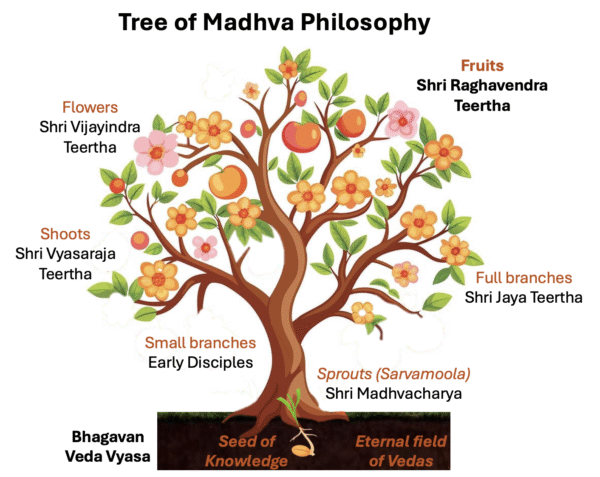हरि सर्वोत्तम । वायु जीवोत्तम | श्री गुरुभ्यो नमः
On the auspicious occasion of Rayaru’s 354th Aradhana here is the beautiful companion to Appanacharya’s popular Raghavendra Stotram. Starting with the famous “पूज्याय राघवेन्द्राय …”, it is followed by Rayaru’s चरम श्लोक that completes the meaning of this verse comparing Rayaru to the sun and moon. The three remaining verses describe the background, purpose, glories and parampara of our Great Guru of Mantralaya.
The last verse additionally included below is from Shri Raghavendra Vijaya (1.13) by Narayana Acharya citing examples of merciful Rayaru’s great gifts to devotees in need. It has the great power of inspiring confidence before speaking in public or attempting anything important.

श्री अणुराघवेन्द्रस्तोत्रम्
पूज्याय राघवेन्द्राय सत्य-धर्म-रताय च ।
भजतां कल्प-वृक्षाय नमतां काम-धेनवे ॥ १ ॥
To the worship-worthy (पूज्याय) Raghavendra (राघवेन्द्राय), who is devoted (रताय) to truth (सत्य) and righteousness (धर्म), the wish-fulfilling celestial tree (कल्पवृक्षाय) to his worshippers (भजताम्), the wish-granting divine cow (कामधेनवे) to those who bow to him (नमताम्), …
दुर्वादि-ध्वान्त-रवये वैष्णवेन्दीवरेन्दवे ।
श्रीराघवेन्द्रगुरवे नमोऽत्यन्तदयालवे ॥ २ ॥
… to the radiant sun (रवये) that dispels the darkness (ध्वान्त) of wrong interpretations (दुर्वादि), to the moon (इन्दवे) that delights the blue-lotus-like hearts of true devotees of Vishnu (वैष्णव), to he who is exceedingly (अत्यन्त) compassionate (दयालवे) – we bow (नमः) to that Guru (गुरवे) Shri Raghavendra (श्रीराघवेन्द्र).
श्री-सुधीन्द्राब्धि-सम्भूतान् राघवेन्द्र-कला-निधीन् ।
सेवे सज्ज्ञान-सौख्यार्थं सन्तापत्रय-शान्तये ॥ ३ ॥
I serve (सेवे) Shri Raghavendra (राघवेन्द्र), the treasure-house (निधीन्) of knowledge and arts (कला), who arose (सम्भूतान्) from the oceanic lineage of (अब्धि) Shri Sudhindra Tirtha (श्रीसुधीन्द्र), for the purpose of imparting(अर्थम्) true (सत्) knowledge (ज्ञान) and bliss (सौख्य), and for the removal (शान्तये) of the threefold (त्रय) worldly miseries (सन्ताप) [i.e. अधिभूत अधिदैव अध्यात्म].
अघं द्रावयते यस्माद्-वेङ्कारो वाञ्छित-प्रदः ।
राघवेन्द्र-यतिस्-तस्माल्-लोके ख्यातो भविष्यति ॥ ४ ॥
By whose grace (यस्मात्) the utterance “Vem” (वेङ्कारः) destroys (द्रावयते) sins (अघम्), and by being the grantor (प्रदः) of desires (वाञ्छित), by this virtue (तस्मात्) the saint (यतिः) Raghavendra (राघवेन्द्र) will be (भविष्यति) renowned (ख्यातः) in the world (लोके).
व्यासेन व्युप्त-बीजः श्रुति-भुवि भगवत्-पाद-लब्धाङ्कुर-श्रीः
प्रत्नैर्-ईषत्-प्रभिन्नोऽजनि जय-मुनिना सम्यग्-उद्भिन्न-शाखः ।
मौनीश-व्यासराजाद्-उदित-किसलयः-पुष्पितोऽयं जयीन्द्राद्-
अद्य श्री-राघवेन्द्राद्-विलसति फलितो मध्व-सिद्धान्त-शाखी ॥ ५ ॥
The seed (बीजः) of wealth of knowledge (श्रीः) sown (व्युप्त) by Lord Veda Vyasa (व्यासेन) in the field (भुवि) of the Vedas (श्रुति), received (लब्ध) and sprouted (अङ्कुर) by Shri Madhvacharya (भगवत्-पाद), nurtured to grow (ईषत्) branches (प्रभिन्नः) by early disciples (प्रत्नैः), and born (अजनि) well-developed (सम्यक्) with fully expanded branches (उद्भिन्नशाखः) through Jaya Tirtha (जयमुनिना), sprung out (उदित) shoots (किसलयः) through the king of saints (मौनीश) Vyasaraja Tirtha (व्यासराजात्) and this (अयम्) flowered (पुष्पितः) through Vijayindra Tirtha (जयीन्द्रात्). Today (अद्य), through Shri Raghavendra (श्रीराघवेन्द्रात्), the fully-branched tree (शाखी) of Madhva’s philosophy (मध्वसिद्धान्त) shines (विलसति) bearing fruits (फलितः) [for devotees].
मूकोऽपि यत्-प्रसादेन मुकुन्द-शयनायते ।
राजराजायते रिक्तो राघवेन्द्रं तमाश्रये ॥ श्री राघवेन्द्र विजय १.१३ ॥
By whose (यत्) grace (प्रसादेन) even a mute person (मूकः) becomes can become (आयते) eloquent like the thousand-tongued Anantashesha, the bed of Lord Mukunda (मुकुन्द-शयन), and the poor (रिक्तः) becomes (आयते) rich as the Emperor of kings (राजराजः) — in that (तम्) Raghavendra (राघवेन्द्रं), I take refuge (आश्रये).

/Raghunath Rao/ “Do your Best … and leave the Rest … “
(All mistakes mine – all credit to Gurus and Acharyas )
|| sarvaṁ śrī kṛṣṇārpanamastu ||





